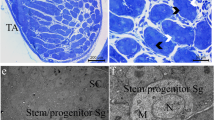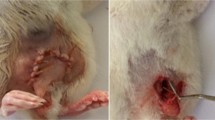Abstract
Spermatogonial stem cells (SSCs) are crucial for maintaining spermatogenesis, studying germ line stem cell biology, and producing transgenic animals. Growth factors, including leukemia inhibitory factor (LIF), epidermal growth factor (EGF), basic fibroblast growth factor (bFGF), and glial cell line-derived neurotrophic factor (GDNF), are essential for in vitro culture of SSCs as well as their self-renewal and maintenance. In this study, we investigated the effects of these growth factors on porcine spermatogonial germ cell (pSGC) colony formation. We determined round alkaline phosphatase (AP)-positive pSGC colonies in the presence and absence of growth factors after 7 days of pSGC culture. EGF was found to be essential to support the formation of AP-positive pSGC colonies. The expression of epidermal growth factor receptor (EGFR) and Erb-B2 receptor tyrosine kinase 2 (ERBB2) was also altered in cultured pSGCs compared to that in feeder cells. We verified the effect of EGF signaling on pSGC colony formation using AG1478 as an EGFR inhibitor and AG879 as an ERBB2 inhibitor. pSGC colonies were observed in low dose AG1478-treated groups with EGF, whereas a high dose of AG1478 suppressed pSGC colony formation. AP-positive colonies were also observed in all AG879-treated groups. Taken together, EGFR and EGF signaling play a critical role in the initiation of colony formation of pSGCs. Our study provides insights into the mechanisms of EGF-mediated colony formation by SGCs derived from porcine testes, and will aid the development of transplantation techniques for the production of transgenic offspring.
Similar content being viewed by others
References
Ohbo, K., S. Yoshida, M. Ohmura, O. Ohneda, T. Ogawa, H. Tsuchiya, T. Kuwana, J. Kehler, K. Abe, H. Schöler, and T. Suda (2003) Identification and characterization of stem cells in prepubertal spermatogenesis in mice. Dev. Biol. 258: 209–225.
Shinohara, T., K. E. Orwig, M. R. Avarbock, and R. L. Brinster (2000) Spermatogonial stem cell enrichment by multiparameter selection of mouse testis cells. Proc. Natl. Acad. Sci. USA. 97: 8346–8351.
de Rooij, D. G. (2017) The nature and dynamics of spermatogonial stem cells. Development. 144: 3022–3030.
Kanatsu-Shinohara, M., N. Ogonuki, K. Inoue, H. Miki, A. Ogura, S. Toyokuni, and T. Shinohara (2003) Long-term proliferation in culture and germline transmission of mouse male germline stem cells. Biol. Reprod. 69: 612–616.
Kanatsu-Shinohara, M., H. Miki, K. Inoue, N. Ogonuki, S. Toyokuni, A. Ogura, and T. Shinohara (2005) Long-term culture of mouse male germline stem cells under serum-or feeder-free conditions. Biol. Reprod. 72: 985–991.
Kubota, H., M. R. Avarbock, and R. L. Brinster (2004) Culture conditions and single growth factors affect fate determination of mouse spermatogonial stem cells. Biol. Reprod. 71: 722–731.
Brinster, R. L. and J. W. Zimmermann (1994) Spermatogenesis following male germ-cell transplantation. Proc. Natl. Acad. Sci. USA. 91: 11298–11302.
Navid, S., T. Rastegar, M. Baazm, R. Alizadeh, A. Talebi, K. Gholami, S. Khosravi-Farsani, M. Koruji, and M. Abbasi (2017) In vitro effects of melatonin on colonization of neonate mouse spermatogonial stem cells. Syst. Biol. Reprod. Med. 63: 370–381.
Dirami, G., N. Ravindranath, V. Pursel, and M. Dym (1999) Effects of stem cell factor and granulocyte macrophage-colony stimulating factor on survival of porcine type A spermatogonia cultured in KSOM. Biol. Reprod. 61: 225–230.
Luo, J., S. Megee, R. Rathi, and I. Dobrinski (2006) Protein gene product 9.5 is a spermatogonia-specific marker in the pig testis: application to enrichment and culture of porcine spermatogonia. Mol. Reprod. Dev. 73: 1531–1540.
Kuijk, E. W., B. Colenbrander, and B. A. J. Roelen (2009) The effects of growth factors on in vitro-cultured porcine testicular cells. Reproduction. 138: 721–731.
Lee, W. Y., H. J. Park, R. Lee, K. H. Lee, Y. H. Kim, B. Y. Ryu, N. H. Kim, J. H. Kim, J. H. Kim, S. H. Moon, J. K. Park, H. J. Chung, D. H. Kim, and H. Song (2013) Establishment and in vitro culture of porcine spermatogonial germ cells in low temperature culture conditions. Stem Cell Res. 11: 1234–1249.
Lee, W. Y., J. T. Do, C. Park, J. H. Kim, H. J. Chung, K. W. Kim, C. H. Gil, N. H. Kim, and H. Song (2016) Identification of putative biomarkers for the early stage of porcine spermatogonial stem cells using next-generation sequencing. PLoS One. 11: e0147298.
Moghal, N. and P. W. Sternberg (1999) Multiple positive and negative regulators of signaling by the EGF-receptor. Curr. Opin. Cell. Biol. 11: 190–196.
Wells, A. (1999) EGF receptor. Int. J. Biochem. Cell. Biol. 31: 637–643.
Liu, A., C. Flores, T. Kinkead, A. A. Carboni, M. Menon, and L. Seethalakshmi (1994) Effects of sialoadenectomy and epidermal growth factor on testicular function of sexually mature male mice. J. Urol. 152: 554–561.
Suarez-Quian, C. A., B. O. Oke, and B. Radhakrishnan (1994) Relationship between submandibular gland epidermal growth factor and spermatogenesis in C3H mice. Tissue Cell. 26: 285–298.
Bartlett, J. M., J. Spiteri-Grech, and E. Nieschlag (1990) Regulation of insulin-like growth factor I and stage-specific levels of epidermal growth factor in stage synchronized rat testes. Endocrinology. 127: 747–758.
Wong, R. W., R. W. Kwan, P. H. Mak, K. K. Mak, M. H. Sham, and S. Y. Chan (2000) Overexpression of epidermal growth factor induced hypospermatogenesis in transgenic mice. J. Biol. Chem. 275: 18297–18301.
Yan, Y. C., Y. P. Sun, and M. L. Zhang (1998) Testis epidermal growth factor and spermatogenesis. Arch. Androl. 40: 133–146.
Shin, I., H. J. Kim, W. H. Nah, H. J. Park, M. C. Gye, and H. Y. Park (2011) Expression of activated HER2 in human testes. Fertil. Steril. 95: 2725–2728.
Abé. K., K. Eto, and S. Abé (2008) Epidermal growth factor mediates spermatogonial proliferation in newt testis. Reprod. Biol. Endocrinol. 6: 7.
Fisher, D. A. and J. Lakshmanan (1990) Metabolism and effects of epidermal growth factor and related growth factors in mammals. Endocr. Rev. 11: 418–442.
Brinster, R. L. (2002) Germline stem cell transplantation and transgenesis. Science. 296: 2174–2176.
Phillips, B. T., K. Gassei, and K. E. Orwig (2010) Spermatogonial stem cell regulation and spermatogenesis. Philos. Trans. R. Soc. Lond. B. Biol. Sci. 365: 1663–1678.
Guan, K., K. Nayernia, L. S. Maier, S. Wagner, R. Dressel, J. H. Lee, J. Nolte, F. Wolf, M. Li, W. Engel, and G. Hasenfuss (2006) Pluripotency of spermatogonial stem cells from adult mouse testis. Nature. 440: 1199–1203.
Tadokoro, Y., K. Yomogida, H. Ohta, A. Tohda, and Y. Nishimune (2002) Homeostatic regulation of germinal stem cell proliferation by the GDNF/FSH pathway. Mech. Dev. 113: 29–39.
Kubota, H., M. R. Avarbock, and R. L. Brinster (2003) Spermatogonial stem cells share some, but not all, phenotypic and functional characteristics with other stem cells. Proc. Natl. Acad. Sci. USA. 100: 6487–6492.
Weiler, E., F. Khalil-Manesh, and H. C. Gonick (1990) Effects of lead and a low-molecular-weight endogenous plasma inhibitor on the kinetics of sodium-potassium-activated adenosine triphosphatase and potassium-activated p-nitrophenylphosphatase. Clin. Sci. (Lond). 79: 185–192.
Park, H. J., R. Lee, W. Y. Lee, J. H. Kim, J. T. Do, C. Park, and H. Song (2017) Stage-specific expression of Sal-like protein 4 in boar testicular germ cells. Theriogenology. 101: 44–52.
Lee, K. H., R. Lee, W. Y. Lee, D. H. Kim, H. J. Chung, J. H. Kim, N. H. Kim, S. H. Choi, J. H. Kim, and H. Song (2014) Identification and in vitro derivation of spermatogonia in beagle testis. PLoS One. 9: e109963.
Aponte, P. M., T. Soda, K. J. Teerds, S. C. Mizrak, H. J. G. van de Kant, and D. G. de Rooij (2008) Propagation of bovine spermatogonial stem cells in vitro. Reproduction. 136: 543–557.
Bost, F., R. McKay, M. Bost, O. Potapova, N. M. Dean, and D. Mercola (1999) The Jun kinase 2 isoform is preferentially required for epidermal growth factor-induced transformation of human A549 lung carcinoma cells. Mol. Cell. Biol. 19: 1938–1949.
Chen, K. S., N. J. Fustino, A. A. Shukla, E. K. Stroup, A. Budhipramono, C. Ateek, S. H. Stuart, K. Yamaguchi, P. Kapur, A. L. Frazier, L. Lum, L. H. J. Looijenga, T. W. Laetsch, D. Rakheja, and J. F. Amatruda (2018) EGF receptor and mTORC1 are novel therapeutic targets in nonseminomatous germ cell tumors. Mol. Cancer. Ther. 17: 1079–1089.
Ge, C., M. Yu, J. N. Petitte, and C. Zhang (2009) Epidermal growth factor-induced proliferation of chicken primordial germ cells: involvement of calcium/protein kinase C and NFKB1. Biol. Reprod. 80: 528–536.
Radhakrishnan, B., B. O. Oke, V. Papadopoulos, R. P. DiAugustine, and C. A. Suarez-Quian (1992) Characterization of epidermal growth factor in mouse testis. Endocrinology. 131: 3091–3099.
Sordoillet, C., M. A. Chauvin, E. de Peretti, A. M. Morera, and M. Benahmed (1991) Epidermal growth factor directly stimulates steroidogenesis in primary cultures of porcine Leydig cells: actions and sites of action. Endocrinology. 128: 2160–2168.
Citri, A. and Y. Yarden (2006) EGF-ERBB signalling: towards the systems level. Nat. Rev. Mol. Cell. Biol. 7: 505–516.
Sooro, M. A., N. Zhang, and P. Zhang (2018) Targeting EGFR-mediated autophagy as a potential strategy for cancer therapy. Int. J. Cancer. 143: 2116–2125.
Gazdar, A. F. and J. D. Minna (2008) Deregulated EGFR signaling during lung cancer progression: mutations, amplicons, and autocrine loops. Cancer. Prev. Res (Phila). 1: 156–160.
Sabra, A., A. A. Ziaee, S. N. Ostad, K. Alimoghadam, and M. H. Ghahremani (2011) Crosstalk of EGF-directed MAPK signalling pathways and its potential role on EGF-induced cell proliferation and COX-2 expression in human mesenchymal stem cells. Cell. Biochem. Funct. 29: 64–70.
Yu, M., Y. Wei, K. Xu, S. Liu, L. Ma, Y. Pei, Y. Hu, Z. Liu, X. Zhang, B. Wang, Y. Mu, and K. Li (2019) EGFR deficiency leads to impaired self-renewal and pluripotency of mouse embryonic stem cells. Peer. J. 7: e6314.
Binsila, B. K., S. Selvaraju, S. K. Ghosh, L. Ramya, A. Arangasamy, R. Ranjithkumaran, and R. Bhatta (2020) EGF, GDNF, and IGF-1 influence the proliferation and stemness of ovine spermatogonial stem cells in vitro. J. Assist. Reprod. Genet. 37: 2615–2630.
Jones, R. B., A. Gordus, J. A. Krall, and G. MacBeath (2006) A quantitative protein interaction network for the ErbB receptors using protein microarrays. Nature. 439: 168–174.
Kedrin, D., J. Wyckoff, P. J. Boimel, S. J. Coniglio, N. E. Hynes, C. L. Arteaga, and J. E. Segall (2009) ERBB1 and ERBB2 have distinct functions in tumor cell invasion and intravasation. Clin. Cancer. Res. 15: 3733–3739.
Iwamoto, R., N. Mine, H. Mizushima, and E. Mekada (2017) ErbB1 and ErbB4 generate opposing signals regulating mesenchymal cell proliferation during valvulogenesis. J. Cell. Sci. 130: 1321–1332.
Acknowledgements
This paper was supported by Konkuk University Researcher Fund in 2019.
Author information
Authors and Affiliations
Corresponding author
Ethics declarations
Neither ethical approval nor informed consent was required for this study.
Additional information
Publisher’s Note
Springer Nature remains neutral with regard to jurisdictional claims in published maps and institutional affiliations.
Competing Interests
The authors declare that they have no competing interests.
Rights and permissions
About this article
Cite this article
Lee, R., Park, HJ., Lee, WY. et al. Effect of Epidermal Growth Factor on the Colony-formation Ability of Porcine Spermatogonial Germ Cells. Biotechnol Bioproc E 26, 677–687 (2021). https://doi.org/10.1007/s12257-020-0372-3
Received:
Accepted:
Published:
Issue Date:
DOI: https://doi.org/10.1007/s12257-020-0372-3




